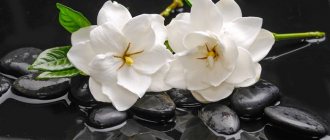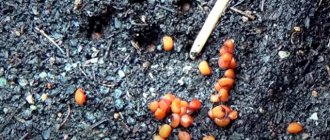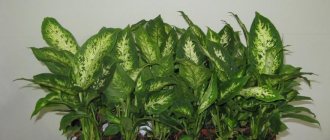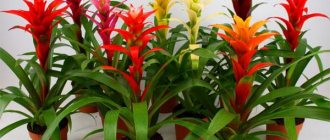Even in the most modest interior of an apartment, luxurious bright gerbera flowers can create coziness and a festive mood. You can, of course, grow garden gerberas in the summer, cut them and collect them into bouquets that will stand in a flower vase in your room for a couple of weeks. But, nevertheless, it is much more interesting to grow this beauty at home in a pot and enjoy its amazing flowering for several months. Good lighting, a mild microclimate in city apartments and knowledge of some of the nuances in caring for indoor gerberas at home will allow anyone to achieve the desired results.
Location
Gerbera loves sunny window sills facing east or west, but will also thrive in other places well lit by diffused sunlight. It should be shaded from direct midday sun, but at other times it simply needs sun. Thanks to its compactness and the chic appearance of its inflorescences, gerbera can decorate any corner of your home. You can find a place for it in the bedroom, in the living room, in the living room and even in the kitchen. It is safe for allergy sufferers. She’s not afraid of drafts, but she loves fresh air - so don’t forget to ventilate her corner regularly. In the summer, the plant can be taken out onto the veranda, balcony or even into the garden, where it will have a great time in the warm season in the open ground.
Diseases
As a result of unsatisfactory care, the plant withers. There may be several reasons for this - from incorrect lighting and watering to the spread of pests. You should respond immediately.
Powdery mildew
Powdery mildew can be identified by the appearance of a whitish and then gray coating that spreads throughout the plant. As a result, leaves with buds fall off. Young gerberas are the most vulnerable.
The prerequisites for such a disease include excessive soil and air moisture, excessive fertilizing and increased temperature. Fungicides should be used to control powdery mildew. The most effective are Fundazol and Topaz.
Late blight
Another disease associated with excess moisture and hot microclimate is late blight. As a result, the rhizome begins to rot and the leaves dry out on both sides. The insidiousness of the disease lies in the fact that the bacteria live in the soil for a long time. Therefore, after a diseased plant, the soil must be disposed of.
At the first visible signs, you should abruptly stop supplying the flower with moisture, and then treat it with Profit, Gold, Ridomil or Previkur.
Mold
If moldy deposits are detected on the soil surface, the plant should be immediately transplanted into new soil and watering should be normalized.
Gray rot
Rot can appear after excessive wetting of the substrate, as well as as a result of excess nitrogen compounds. This manifests itself as a gray coating on the leaves, after which they begin to fall off. To cope with the scourge, reconsider your attitude to watering and treat the gerbera with any fungicide. In this case, the recommended drugs are Rovral and Fundazol.
Brown spots on leaves
At elevated indoor temperatures, coupled with high humidity and incorrect fertilizing, Alternaria can develop on the plant. Its symptoms can be characterized by the appearance of a brown spot on the surface of the leaf, which over time begins to lighten in the center.
Sometimes, when humidity rises, the affected area becomes covered with a velvety coating. If an outbreak occurs, you should prevent the flower from withering and treat it with a fungicide as soon as possible according to the instructions.
Yellow spots on leaves
As the cucumber mosaic develops, the leaves of the gerbera begin to turn yellow in parts. The lesions appear as medium-sized yellow spots, sometimes with a green tint, that have a clearly defined outline.
One of the reasons is aphids, as well as cold air along with high humidity and lack of light. To combat the disease, it is worth optimizing the microclimate of the room and carrying out regular prevention.
Wilting plant
If your flower begins to rapidly lose growth and fade, then most likely it is infected with sclerotinia. You can verify this by examining the plant - spots with a depressed texture may appear on it, where a gray coating then appears.
The cause of the problem lies in the excess of fertilizing and watering. You should replace the old substrate with a new one, giving preference to a more breathable one, and carry out preventive measures with any fungicide.
Drying leaves
If the plant falls heavily, you should find the cause of the gerbera’s malaise, identifying either the presence of pests, or determining the appropriate symptoms, and then taking action.
When purchasing any flower, remember that you will have to take responsible care of it. Otherwise, you will not only ruin the plant, but also throw away your savings. Good luck!
Did you like the article? Save it to your Pinterest! Hover over the image and click “Save.”
Lighting
Gerberas really respect direct sunlight. This is a prerequisite for the formation of a lush crown of leaves and flowering. Only, if the flower is on a south window, it is better to protect it with a curtain or blinds at midday.
The optimal length of daylight for comfortable maintenance of gerbera throughout the year is at least 12–13 hours. Therefore, from approximately mid-autumn to mid-spring, we recommend illuminating the flower to these levels using conventional fluorescent, LED or special phytolamps, placing them at a slight angle at a distance of about 80 cm above the pot. Sufficient lighting is a necessary condition for flowering.
Main problems when growing
Why do the leaves turn yellow?
With Alternaria blight, brownish spots are visible on the foliage.
Then the leaves begin to turn pale and turn yellow.
Also, with mosaic, yellowish-green spots appear, and then leaf necrosis develops.
It is best to treat gerbera with Radomil Gold.
This video once again shows how to properly care for indoor gerberas:
How to achieve lush flowering
Despite its love for bright sun, the plant stops blooming if there is too much light. Gerbera needs no more than 12 hours of daylight. It blooms most luxuriantly from late August to November.
If a gerbera does not bloom for more than 3 months, this means that the reason is not the light, but something else. A plant may stop forming buds if it is planted in a pot that is too large for it, then the crop directs all its energy to the growth of rhizomes. If you put nitrogen under the gerbera, it will also stop flowering.
Temperature
The optimal temperature during the growing season and flowering is considered to be 20–25 degrees. in the daytime and 18-20 degrees. at night. This corresponds to natural indicators in its homeland. During the winter holidays, the temperature in the room is reduced to 14–16 degrees, while reducing the watering rate. At 12 gr. In warm temperatures, gerberas go into “hibernation”: almost all processes slow down, flowering is excluded. Temperature 8-10 degrees. is critical for home gerbera, although in its native places it can withstand lower temperatures due to the fact that the roots there are, after all, in warmer and more humid layers of soil.
The flower does not like sudden changes in temperature, especially during flowering. The heat is 30 degrees. Gerbera also does not tolerate higher levels well - the inflorescences quickly wither, the leaves lose their tone. On such days, remove the flower to cooler places, shade it, and ventilate the premises more often.
Growing from seeds
You can buy gerbera in a pot at a flower shop, but if you want to grow a flower from the very beginning, you should buy seeds. What to do with them next:
- Small containers (for example, boxes) are filled with substrate.
- Seed material is sown and a little sand is sprinkled on top.
- The soil is sprayed with a spray bottle.
- It is very important to create greenhouse conditions; for this you can cover the crops with glass or film.
- The boxes are placed in a warm and bright place.
The first growths can be seen already on the 7-8th day. During this period, the glass (film) is removed to avoid combustion.
After two full-fledged leaves are formed on the seedlings, you can start picking. The seeds are planted in the spring, and during this year the gerbera will bloom.
Watering
During the growing season and flowering, gerberas in a pot need to be watered regularly, and the amount of liquid with each watering should be approximately the same. The soil in the depths of the pot should be kept slightly moist and slightly dry on the surface of the soil. The ideal watering scheme is as follows: the soil should be damp for 4 days, and then dry for 2 days. On cool days, the dose of water is reduced accordingly, and on hot days – increased.
It is best to pour water around the edges of the pot using a watering can with a long spout. It is not necessary for water to directly fall on the roots, much less on the leaves and inflorescences.
Watering through a tray is also allowed. Just remember to remove excess water that has not been absorbed into the soil from the pan approximately 20-30 minutes after watering.
We recommend loosening the soil in the pot between waterings so that the roots have free access to oxygen.
Water for irrigation should be soft (rain, snow, boiled or standing for 24 hours), at room temperature, not lower than 20 degrees, to avoid the development of fungal infections. Even in the summer heat, you cannot water this plant with cool water - the roots will rot.
This may be interesting: Methods for propagating Balsam
In autumn-winter, watering should be significantly reduced, as well as the temperature of the flower. Water only after the top layer of soil has dried at least 2-3 cm. You can determine the need for watering using a match or a toothpick, as well as by the appearance of the plant: if the gerbera is “thirsty,” its leaves droop and lose tone.
Types of gerbera with photos
At home and with proper care, indoor gerberas can bloom several times a year. All presented flowers, which are grown on plots and at home, were the result of the selection of two varieties: classic green-leaved and Jameson. And within these species, varieties and varieties are divided according to color, flower size, and doubleness.
Low-growing and compact species are suitable for growing on a windowsill, which include the following varieties:
Festival - characterized by a short stem and large multi-colored flowers.
Aldebaran and Alcor - have small flowers and narrow leaves, often used for industrial cultivation.
Jupiter, Vega, Migar - the flowers have narrow leaves, and the flowers are slightly larger.
Mars – This variety has medium-sized leaves and large flowers.
Gerbera Mix is especially popular among gardeners, not only because of its beauty, but also because of its varied colors. It does not reach large sizes when grown in pots, and also does not require special care.
How a gerbera wakes up and falls asleep, video:
How Gerbera wakes up and falls asleep
Air humidity
Gerbera does not tolerate dry air well. The optimal humidity level for it is 70–80%. If the indicators are greatly reduced, especially during the heating season, the humidity must be increased by all available means. It is not advisable to spray the plant itself - neither the leaves nor the flowers like it. But regularly spraying the space surrounding the flower, creating a water suspension or fog around the gerbera, is very necessary. There are other ways to increase indoor humidity, for example:
- place the pot in a deep tray, at the bottom of which is a layer of wet expanded clay, pebbles, sphagnum moss or coconut fiber;
- cover the radiators with wet towels;
- create a gerbera “company” of other plants that evaporate moisture from the leaves;
- Place wide containers of cool water around the gerbera;
- Buy a household humidifier and use it.
If the humidity in the room, on the contrary, is too high, above 80-85%, this will make the gerbera vulnerable to fungal and other infections, especially in winter. In this case, ventilation, reducing the amount of watering, and canceling spraying will help.
Potting Guide
If there is a need to rejuvenate the plant, it is removed from the pot and the bush is divided into parts. This procedure is best performed after flowering, before the gerbera goes to bed. The planned annual planting in a larger container takes place in the spring. In this case, a step-by-step algorithm is followed:
- a layer of expanded clay, broken brick or ground stones is placed in a new pot;
- the plant is carefully removed from the old container by transshipment and relocated along with the earthen lump;
Important! During the replanting process, it is important not to damage the roots, otherwise the gerbera will get sick or will not be accepted into the new pot at all.
- the space between the earthen lump and the walls is filled with fresh substrate.
In the process of transplantation
All that remains is to water the plant and put it in its permanent place. The first days after transplantation, the bush requires special attention.
The soil
To grow indoor gerbera, it is best to purchase ready-made store-bought universal soil for flowering indoor plants. In the wild in South Africa, gerbera grows in soils rich in minerals but almost devoid of organic matter.
It is also possible to prepare the substrate yourself. It should be nutritious, loose, with a slightly acidic reaction. Mix leaf soil, peat chips, coarse sand (or sphagnum moss), small pieces of charcoal in a ratio of 2:1:1:1. Add some pine bark. It is important that the soil does not contain humus or compost - a minimum of organic matter! (They may burn the tender gerbera roots). The soil mixture of the specified composition will be quite fertile and permeable, it will provide free access of air to the root system of the plant.
Why do indoor gerbera leaves turn yellow and dry: what to do?
Gerbera leaves turn yellow and dry if they are attacked by pests :
- Whitefly . The plant should be treated with a preparation containing permethrin.
- Spider mite . To get rid of it, spray the leaves 2-3 times a day with clean water. If this does not help, you need to use the drug Actellik
Important: Yellowing occurs when overwatering. Reduce watering if your gerbera begins to wilt and turn yellow.
Gerbera transplant
The bright life span of indoor gerberas is short, only 3–4 years. Then the bushes lose their decorative properties and bloom less frequently and sparingly. Through reproduction, young specimens are grown, and old ones are thrown away. Therefore, you will only have to do the transplant a couple of times.
Replanting after purchase
The first transplant is carried out soon after purchasing the flower, since a store-bought transport pot and the substrate in it are not suitable for long-term cultivation of the flower. Plan this procedure 2-3 weeks after purchase - this time is enough to adapt the gerbera to new conditions. You will need to remove the flower from the shipping pot and shake off or scrape off as much of the store-bought substrate as possible with a wooden stick. Do not trim or pick off the gerbera roots. It is better to disinfect the prepared pot, even if it is completely new.
There should be drainage holes at the bottom of the pot, then a layer of drainage made of expanded clay (pebbles, crushed stone, pieces of polystyrene foam, small ceramic shards) at least 2-3 cm thick. Next comes a layer of fresh, preferably sterilized substrate (about a third of the pot) . Place the bush on the substrate in the center and carefully fill the roots along the edges of the pot. Make sure that the root collar is not buried. The root rosette should rise 2-4 cm above the ground surface.
The transplant should be done during the dormant period, when the gerbera does not bloom. If you were given a pot of blooming gerbera, then it is better to leave it in the same pot so as not to disturb the flowering process and not spoil your pleasure. Replant after the plant has finished flowering.
Planned transplant
You will have to plan the next transplant for next year, when the gerbera has grown enough. The optimal time for transplantation is the end of the dormant period. This is approximately from the end of February to mid-March. Some gardeners recommend replanting after flowering has ended, somewhere in late autumn. We are for the first option.
- Replant the gerbera using the transshipment method, while trying to disturb the roots as little as possible.
- After transplanting, compact the substrate and water it moderately. Place the flower pot in the shade for 3–5 days to prevent direct sunlight.
- If after a week the transplanted gerbera bush does not look cheerful, as if it has not yet recovered from stress, spray the surrounding air and build a greenhouse around the flower, for example, from polyethylene. Let the plant in it grow stronger and begin to grow. Get rid of accumulating condensate in a timely manner by ventilation, so as not to provoke the development of rot.
This may be interesting: Description of Streptocarpus species and varieties with photos
Carry out the first feeding no earlier than a month after transplantation. Use mineral nitrogen-containing fertilizers that stimulate the flower to actively grow green mass.
Description and photo of a houseplant
Indoor gerbera is a perennial, magnificently flowering plant. The foliage is collected in a small basal rosette. The flowers, which look like large chamomiles, are a huge advantage. The color palette is surprising, it is so diverse that you can grow a whole rainbow on your windowsill. There is no blue tint.
Indoor gerbera is low-growing and takes an average of 3-4 years to grow. Then its development and flowering decreases, and the flower is replaced with a new specimen.
Look at the photo of what an indoor gerbera looks like.
What kind of pot do you need?
The diameter of the pot should not be too large, only 2–3 cm wider than the root system of the flower. Crowding in a pot is one of the conditions for abundant flowering of gerberas. Volume - approximately 1–1.5 liters.
A deep pot made of unglazed ceramics is best suited for gerberas - this will allow air to pass well to the roots of the plant. But in winter, on a cold windowsill, the roots of the gerbera in such a pot can become hypothermic. This should not be allowed, because gerbera is very sensitive to this. In this case, foam or a wooden stand under the pot for thermal insulation will help.
Diseases and pests
When growing gerbera indoors, a gardener may encounter the following problems:
- The leaves are turning pale . This happens when the lighting is too intense. In order to avoid this in the spring and autumn, the bushes should be shaded from the midday rays of the sun.
- The bush looks painful . A bush becomes infected with a fungal disease when there is excessively high humidity and poor ventilation.
- The leaves are brightening . If a flower recently purchased in a store begins to lose its bright color, this may be due to its adaptation to new conditions or poor lighting. As a rule, purchased plants lose their brightness. This is due to the fact that flowers grown for sale are often fed with special substances that make the color of their foliage more saturated.
- Withering and death of a flower . Make sure that there is no stagnation of liquid in the root system, as this can cause the death of the gerbera. Particular attention should be paid to watering in the cold season.
- Harmful insects . Whiteflies, mites, aphids and scale insects can settle on the flower.
Fertilizers
Fertilizing is applied only during the active growing season. From the beginning of spring to the end of November, the plant is fertilized every 1.5–2 weeks. Indoor gerbera does not like natural organic matter. It is preferable to feed with mineral supplements. Purchased complex fertilizers for flowering plants (Master, Uniflor, Florovit, Agricola) are suitable. We recommend halving the concentration of the product in the solution compared to the instructions.
Pay attention to the composition. During different periods of gerbera development, use a specific composition of fertilizer. For example, during the growth of green mass, fertilizers should contain more nitrogen components. During flowering - potassium and phosphorus. It’s good if iron is included in the fertilizer, since indoor gerberas also need it. You will learn about its deficiency in the soil by pale yellow spots spreading on the leaves, indicating the development of chlorosis. Rusty nails buried in a pot help. Among chemical agents, you can use Micro-Fe and Ferovit preparations.
What does an indoor gerbera look like?
In its natural environment, the flower reaches impressive sizes. Large gerbera inflorescences are similar in appearance to garden chamomile, but only with bright petals in warm shades. A variety with double flowers can be mistaken for an aster from a distance.
Indoor gerberas
The culture belongs to the perennial Compositae plants. For indoor cultivation, breeders developed indoor gerbera - a compact bush no more than 0.3 m high.
Flowers grown for home use differ in the shape of the inflorescences and the shades of the petals. But the basic structure of all representatives of this species of Astrov is the same.
External signs of gerberas
| Characteristics | Description |
| Stem | Single shortened strong peduncle, the average height of which is 20-25 cm |
| Leaves | Large, elongated, pubescent, light green in color. Collected in a basal rosette. The pinnately dissected plates have notched wavy edges |
| Flowers | Large, up to 5 cm in diameter, in the form of a bright colorful basket. The shades contain almost all the colors of the rainbow (except blue). According to the number and arrangement of petals, the inflorescences of gerberas are simple, double and semi-double. In some varieties the core is light (usually yellow), in others it is dark |
| Rhizome | Powerful, consisting of a large number of cord-like roots |
After flowering, the plant produces a seed-bearing fruit, 1 g of which can contain from 300 to 500 small grains. They can be collected for subsequent propagation of new bushes.
Reproduction of gerbera at home
Gerbera readily reproduces in captivity in several ways. Let's look at them in order.
Dividing the bush
This is the easiest way to get a new gerbera bush from a healthy plant at the age of 3-4 years, on which several basal rosettes have formed. In the spring, when replanting a flower, it is divided into parts so that each has 2-3 growth points (at least one) and part of the root system. The root system should first be soaked for 2–3 hours in warm water, slightly pink from potassium permanganate. Afterwards, the roots should be carefully cleaned from the soil and unraveled, if possible, by hand. Divide the roots with a clean knife or scissors. Sprinkle all cuts with crushed charcoal (activated) charcoal or cinnamon.
Transplant the bushes obtained by dividing into separate small pots filled with a substrate suitable for adult gerberas, and water. Carry on with your care as usual. When replanting, make sure that the growing points are 2-3 cm above the soil surface. Rooting takes a long time, from six months to a year, then flowering can occur only 10-12 months or the next year after replanting.
By cuttings
This method is less effective - the cuttings often rot. But you can try. Cut a part of the stem diagonally from the plant, about 10 cm in length, with 2-3 leaves. It is possible to root the cuttings in sand, perlite or vermiculite, covering the container on top with a plastic bag or glass cup (jar), maintaining high humidity, a temperature of 25–27 ° C and, if possible, bottom heating. When a new leaf appears on the cutting, we can assume that rooting was successful. Now the cutting can be transplanted into a pot with suitable soil and cared for as an adult plant.
Growing from seeds
Growing gerbera at home from seeds is a rather complex and time-consuming method. Moreover, it does not guarantee the preservation of the main varietal characteristics of the flower, such as dwarfism, double petals, their shades and other “highlights” of the variety. However, you can collect the seeds yourself or purchase them at the store. Seeds retain good germination rate (more than 50%) for six months. If the seeds are more than eight months old, there is no point in planting them. Gerbera specimens grown from seeds will bloom only after two years.
The optimal time for sowing seeds is from late January to March. Sow seeds in containers or other containers from which you can build a greenhouse. As a substrate, use a mixture of sand and peat chips, which must be well moistened before planting.
- Spread the seeds over the surface without burying them, sprinkle with a thin layer of fine sand on top.
- Close the lid of the container (cover the container with glass or film). Keep in a dark, warm place until germination. Ventilate daily to remove condensation. After 8-10 days, the first shoots will begin to appear.
- Now move the greenhouse to a bright place at a temperature of 18-20 degrees. Protect from direct sunlight.
- When the second true leaves appear on the seedlings, they should be planted in small plastic cups (drainage holes and a drainage layer are required!), and into the same substrate. Try to harm the roots as little as possible.
- When young gerberas have 4–5 leaves, they should be transplanted into pots with a diameter of 9 cm in a substrate suitable for adult gerberas. Then take care as usual.
Reproduction methods
There are two ways to propagate gerbera at home:
- seed;
- dividing the bush.
How it all happens:
- Seed propagation. Seed material can be purchased at a flower shop.
For planting you will need a wooden container. The seeds are deepened by 3 centimeters and irrigated with water. Cover with glass to create a greenhouse effect. Full shoots will appear in 2 weeks. When the seedlings get stronger, pick them. Pots are chosen no more than 10 centimeters in diameter. Planting is best done from February to April. - Dividing the bush. You can divide the rhizome at the time of transplantation, in the spring.
The plant must be mature (from three years old). The gerbera is carefully removed from the container, the remaining soil is removed from the root system, and the rhizome is cut into 5 parts. Each new specimen must have at least a couple of growth points. New plants are planted according to the standard scheme.
Landing Features
Gerbera indoors belongs to the family of herbaceous plants, perennials.
Its flowers in structure resemble a large chamomile with a daisy-shaped center. Densely planted petals make it 5 times more spectacular. This Astrov variety is low growing. Five or seven flowers in one pot will give your home a chic look. This result can be achieved if you choose the right pot. It must be made of clay. Thanks to the porosity of the material, the roots will be able to breathe. Moreover, this helps maintain the required temperature in the soil.
Transplantation of purchased specimens should be carried out 14-20 days after purchase. During this period, the plant adapts to new conditions. The stems and leaves will become more elastic and raised. When transplanting, you need to consider the following:
- the size of the pot is twice as large as the previous one;
- treat the container with boiling water to disinfect;
- completely replace all the soil, carefully shaking off the temporary soil from the roots;
- young sprouts need additional feeding, frequency of fertilization: at first every 4-8 days.
As shown in the photo, caring for indoor gerbera at home includes creating favorable conditions for it to flourish. Both in the garden and at home, it does not require special attention.
Prolonged illumination leads to degeneration of the variety. The plant becomes depleted and disappears within just 2 years.
Temperature and humidity
Proper care of indoor gerberas also includes observing temperature restrictions. Although this is a fairly hardy plant, there is still no need to overuse it. Having entered a dormant period, Transvaal chamomile (another name for a flowerpot) may stop blooming altogether. The optimal conditions for its cultivation are:
- in winter at least 11-14°C;
- in the warm season from 20 to 25°C;
- limit the possibility of frequent temperature changes;
- provide relatively high humidity.
It is not recommended to keep the plant on the balcony in winter. Dampness and cold put the gerbera in a sleepy state. Over time, she may just die.
The homeland of this flower is Africa (Madagascar Island), as well as Asia. In this regard, it is important to take into account that the climate in those parts is tropical. Therefore, it is best to create natural living conditions for an indoor gerbera flower.











